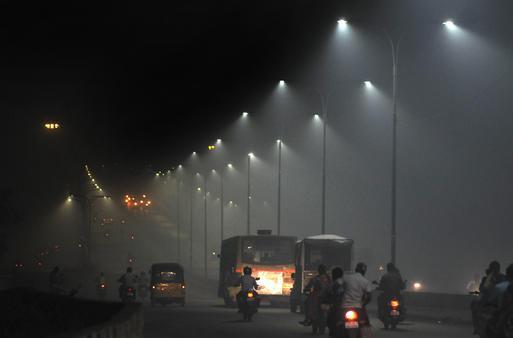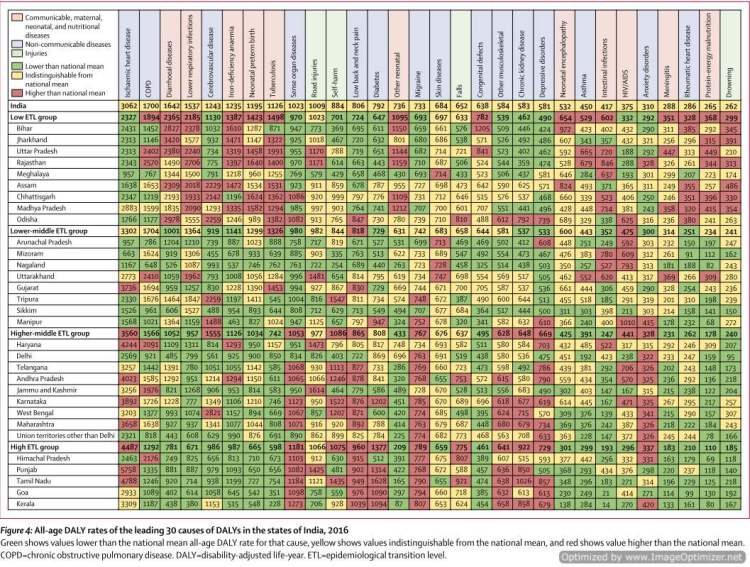
The first comprehensive analysis of the health of India’s 1.34 billion citizens has been published on November 14 in The Lancet. The study estimates the key drivers of ill health, disability, and premature death in all 29 States. It has analysed 333 diseases and injuries and 84 risk factor trends for each State between 1990 and 2016 as part of the Global Burden of Disease 2016 study.
The researchers divided India’s states into four groups according to their level of development or epidemiological transition, using the ratio of illness and premature death caused by communicable, maternal, neonatal, and nutritional diseases (CMNNDs) versus non-communicable diseases (NCDs) and injuries as an indicator. These States with different phases of epidemiological transition show wide inequalities in the magnitude and progress against various diseases.
Epidemiological transition level (ETL) in 2016 is defined as the ratio of all-age DALYs due to CMNNDs versus those due to NCDs and injuries together. A smaller ratio indicates advancing EPL — higher burden of NCDs and injuries than CMNNDs. As expected, Bihar, Jharkhand, Uttar Pradesh, Rajasthan, Meghalaya, Assam, Chhattisgarh, Madhya Pradesh, and Odisha had low EPL, while Himachal Pradesh, Punjab, Tamil Nadu, Goa, and Kerala had high EPL.
States that had low EPL had lower percentage of deaths (35%) compared with NCDs (55%), while States with high EPL showed the reverse — CMNNDs accounted for 16% and NCDs accounted for 72% of deaths.
“The transition of disease epidemiology in India towards a dominance of NCDs and injuries from 1990 to 2016 is remarkable, with all states having a higher disease burden from NCDs and injuries than CMNNDs in 2016, in contrast to 1990, when the majority of disease burden in most states was due to CMNNDs,” says the paper.
The Indian population has gained nearly a decade of life expectancy since 1990, rising to 66.9 years in men and 70.3 years in women. Once again there are wide inequalities between States, with life expectancy for women ranging from 66.8 years in Uttar Pradesh to 78.7 years in Kerala.
Since 1990, India has made substantial gains in health, with the overall health loss from all diseases and conditions about one-third less per person in 2016 than in 1990. But progress has been mixed, with greater improvements in states at the most advanced phases of development (Kerala and Goa), compared to those in the earlier stages (Assam, Uttar Pradesh and several other poorer north Indian states).
 Child health remains a particular concern, with high levels of neonatal and under-5 disease relative to other age groups. The under-5 mortality rate has reduced substantially since 1990 in all states, but rates in Assam (52 deaths per 1,000 livebirths) and Uttar Pradesh (48 deaths) are four times higher than in Kerala (13 deaths).
Child health remains a particular concern, with high levels of neonatal and under-5 disease relative to other age groups. The under-5 mortality rate has reduced substantially since 1990 in all states, but rates in Assam (52 deaths per 1,000 livebirths) and Uttar Pradesh (48 deaths) are four times higher than in Kerala (13 deaths).
“The high neonatal and under-5 disease burden relative to other age groups, predominantly due to the leading CMNNDs, continues to be a major priority for India. Intensive efforts to reduce this burden are necessary to meet the Sustainable Development Goals targets in 2030,” says the paper.
Overall, the burden from CMNNDs has decreased. Yet, diseases that primarily cause illness and death in children and mothers continue to dominate in the country. Lower respiratory infections and diarrhoeal diseases were the third and fourth leading causes of health loss in 2016, accounting for about 9% of all premature death and ill health.
Jharkhand has rates of death and illness due to diarrhoeal disease nine times higher than Goa, while Rajasthan has rates due to lower respiratory infections seven times higher than Kerala.
NCDs a major cause of disease burden
As a result of urbanisation and ageing, the burden of NCDs is large and rapidly rising in all states. The fastest-growing causes of ill-health over the last 26 years were diabetes (increased by 174%) and ischaemic heart disease (up 104%). Ischaemic heart disease (responsible for 8.7% of the disease burden in 2016) and (COPD; 4.8%) were the leading causes of premature death and ill health in 2016, overtaking lower respiratory infections and diarrhoeal diseases. More than 60% of deaths (6.1 million) in India in 2016 were due to NCDs, up from about 38% in 1990.
Rapid urbanisation is responsible for rising deaths and health loss from road injuries in most states since 1990, highlighting the lack of a comprehensive national policy for injury prevention.
Other highly preventable risks such as poor diet (eg, diets high in salt and low in vegetables and fruit), high blood pressure, high cholesterol, and high body mass index are contributing to the growing burden of NCDs. Together they accounted for almost a quarter of poor health in 2016—over two times more than in 1990. Worryingly, the burden of these risks has increased in every state since 1990, with generally higher rates in states in more advanced stages of epidemiological transition (Punjab and Tamil Nadu).
Air pollution
One area that needs special attention is exposure to air pollution which is among the highest in the world contributing to both NCDs and communicable diseases. In particular, the exposure to ambient outdoor air pollution has increased by around 17% since 1990. Ambient outdoor and household air pollution together are responsible for almost 10% of the total disease burden in 2016, highlighting the need to increase the use of cleaner technologies to reduce air pollution from various sources. The burden is highest in the northern states, with Rajasthan, Uttar Pradesh, and Bihar having levels of premature death and ill health due to air pollution around three times higher than Kerala and Goa.
Exposure to air pollution in India is among the highest in the world contributing to both NCDs and communicable diseases. Disease burden due to air pollution is highest in the low ETL state group, with Rajasthan, Uttar Pradesh, and Bihar having the highest DALY rates. The burden from household air pollution is on the decline across all ETL state groups in India on account of the decreasing use of solid fuels for cooking. However, this decline was least in the low ETL group, suggesting that targeted subsidies to accelerate the transition to clean fuels is warranted.
Leading risk factors
The leading risk factors in India in 2016 responsible for more than 5% of the total DALYs each were child and maternal malnutrition (undernutrition; 14·6%), air pollution (9·8%), dietary risks (unhealthy diet; 8·9%), high systolic blood pressure (8·5%), high fasting plasma glucose (6%), and tobacco use (includes smoking, second-hand smoke, and smokeless tobacco (5·9%).
The researchers say that the risk factors included in the report only explain about half of the disease burden in India, emphasising the need for understanding the additional broader determinants of health such as income and education.













